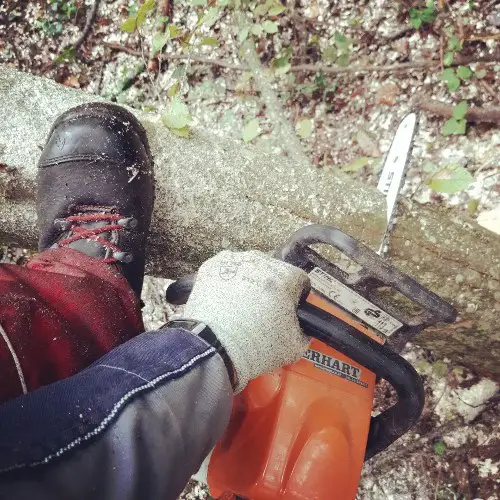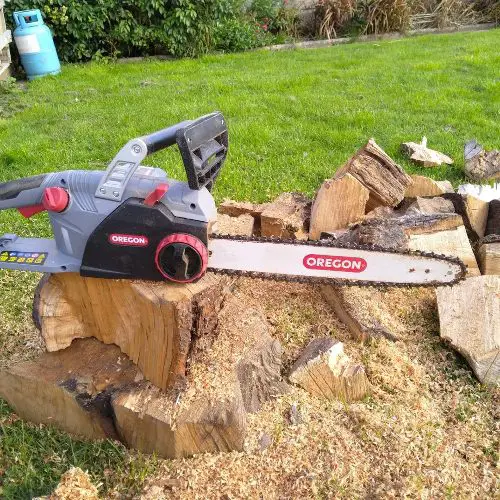A chainsaw is one of the most versatile tools you can have in your arsenal. It is also some of the most dangerous. That is why it is so important to choose the right size chainsaw for the job you are doing.
Choosing a suitable chainsaw can be a daunting task. With all of the different saws on the market, how do you know which product is perfect for you? To know this, you must first understand the different types of saws available, and what each of them is designed for.
In this blog post, we will discuss the different dimensions of chainsaws and help you decide which tool is good for you. Whether you are a homeowner or a professional logger, we have the information you require to make an informed decision. So, what length chainsaw do you want? Keep reading to find out!
How to choose the optimal size?
What size chainsaw do I have to buy? is primarily determined by the length of the guide bar.
The metal bar that the chainsaw’s chain rotates around is called the guide bar (or blade).
Here’s how to measure a chainsaw if you already have it and are unsure of its length:
• Carefully measure the distance with a tape measure between the guide bar’s base, where it enters the engine housing, and the chain’s tip at the farthest end of the bar.
• Round the measurement to the next even number, such as 14 inches, 16 inches, 18 inches, etc., if it is an odd length.
Size recommendations
Below are general recommendations on what the right saw is most suited for common tasks around the home. If you’re not sure which one to get, err on the side of caution and choose a saw with a longer guide bar.
PRUNING
A 6″ to 10″ chainsaw is the appropriate instrument for the job if most of your chainsaw demands involve clipping little branches or bushy plants with thin branches. However, a small handsaw would be better suited for the job if the branches are only a few inches thick or even thinner than that.
REMOVING BRANCHES
If you’re just looking to remove some branches from your woods, an 8″ to 12″ chain saw will do the trick. Keep in mind that these smaller saws can be difficult to control, so if you’re not experienced with using them, it’s wise to ask somebody else to do the job for you.
FELLING SMALL TREES

For felling small plants (those that are less than 12 inches in diameter), a 12″ to 14″ chain saw is your safest bet. These saws are lightweight and easy to maneuver, making them perfect for beginners or those who don’t have a lot of upper body strength.
SPLITTING FIREWOOD
If you’re looking to split some firewood, a 14″ to 16″ chain saw is what you need. These larger saws can handle thicker logs, but they’re still easy enough to use that most people shouldn’t have any trouble operating them. Just be sure to use caution when handling the larger pieces of wood.
FELLING MEDIUM TREES
For medium-sized trees (those that are between 12 and 20 inches in diameter), you’ll have to use a 16″ to 18″ chain saw. These saws are on the heavier side, so they may be more difficult to control if you’re not used to using them. But with a little practice, you should be able to handle them just fine.
FELLING LARGE TREES
The biggest chain saws on the market are designed for felling large saplings (those that are 20 inches or more in diameter). If you’re not an experienced logger, we recommend leaving this job to the professionals. These saws are very heavy and can be difficult to control, so unless you know what you’re doing, it’s advisable to leave them to the experts.
Factors to consider while selecting chainsaw dimensions:

Wood Diameter: The thickness of the wood you’ll be cutting is one of the most important factors to consider when choosing a chainsaw. If you’re only going to be cutting small branches, then you won’t demand as powerful of a saw as someone who has to cut through thicker trunks.
Experience Level with Chainsaws: Another thing to factor in is your experience level with chainsaws. If you’re a beginner, you’ll want to look for a saw that is easy to control and has fewer safety hazards. On the other hand, if you’re more experienced, you might be able to handle a bigger, more powerful saw.
Chainsaw Control: When you’re using a chainsaw, it’s important to have good control over the tool so that you can avoid accidents. Look for features like an anti-kickback brake or chain break that will help you keep the saw under control.
Physical Strength: Another thing to think about is your physical strength. A chainsaw can be a heavy tool, and if you don’t have the muscles to handle it, you could end up injuring yourself. Be honest with yourself about whether or not you can handle a big, bulky chainsaw before making your purchase.
Location: The type of terrain where you’ll be using your chainsaw is also important to consider. If you’re only going to be working on flat ground, then almost any type of saw will do. But if you plan to cut through logs on hilly or uneven terrain, then you might be needing a more specialized saw.
Frequency: How often do you plan on using your chainsaw? If it’s just going to be for occasional use, then you might not even require such a powerful or expensive model. But if you plan on using it regularly, then it’s worth investing in a high-quality chainsaw that will last longer and require less maintenance.
FAQS
What if you need more than a single size?
If you wish to make more than an individual measurement, then it’s better to buy multiple saws. That way, you’ll always have the ideal tool for the job, and you won’t have to worry about overworking a saw or damaging it by trying to cut through something too big.
In case, you are out of budget, choose the lesser one instead. In contrast to the larger versions, you will be able to often use your smaller chainsaw. You can customize the length of the bar as well.
How do I maintain my chainsaw?
Maintaining your chainsaw is important if you want it to last for a long time. Be sure to read the owner’s manual that came with your saw so that you know how to properly care for it.
In general, you should oil the chain and bar regularly, and sharpen the chain when it starts to get dull. You should also clean the air filter and spark plug regularly to keep the saw running smoothly.
Conclusion
Now that you know what kind of chain saw is optimal for each type of job, it’s time to get out there and start cutting!
Just remember to use caution when handling these powerful tools, and always consult an expert if you’re unsure of how to proceed. With the proper precautions, felling timber can be a fun and rewarding experience for all involved.
We hope this guide helped find the best chainsaw sizing for you. If you have any questions or comments, feel free to leave them below. We will try our utmost to get back to you as soon as possible.

I am William Anderson and I’m the founder of this website. I started this site because I was tired of dealing with the problems that come with using Saw Tools. I wanted to help others avoid the time and frustration I had, So I started this site based on my own experience and what I’ve learned from other professionals and resources.